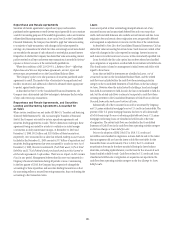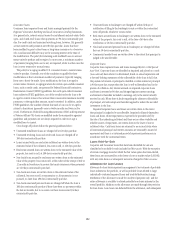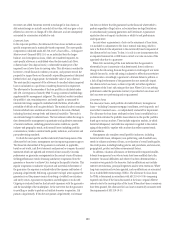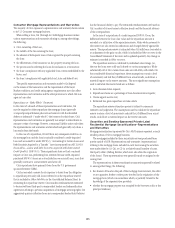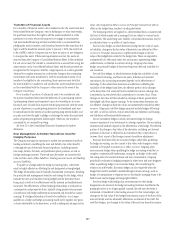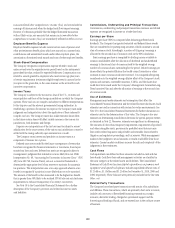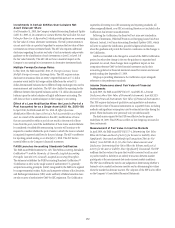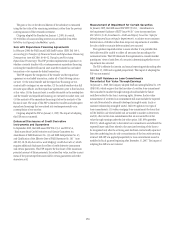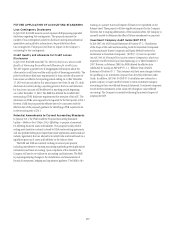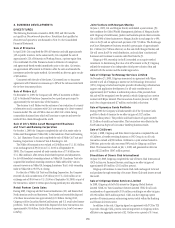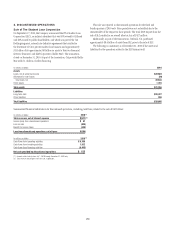Citibank 2010 Annual Report Download - page 171
Download and view the complete annual report
Please find page 171 of the 2010 Citibank annual report below. You can navigate through the pages in the report by either clicking on the pages listed below, or by using the keyword search tool below to find specific information within the annual report.
169
ACCOUNTING CHANGES
Change in Accounting for Embedded Credit Derivatives
In March 2010, the FASB issued ASU 2010-11, Scope Exception Related to
Embedded Credit Derivatives. The ASU clarifies that certain embedded
derivatives, such as those contained in certain securitizations, CDOs and
structured notes, should be considered embedded credit derivatives subject to
potential bifurcation and separate fair value accounting. The ASU allows any
beneficial interest issued by a securitization vehicle to be accounted for under
the fair value option at transition on July 1, 2010.
The Company has elected to account for certain beneficial interests issued
by securitization vehicles under the fair value option that are included in
the table below. Beneficial interests previously classified as held-to-maturity
(HTM) were reclassified to available-for-sale (AFS) on June 30, 2010, because
as of that reporting date, the Company did not have the intent to hold the
beneficial interests until maturity.
The following table also shows the gross gains and gross losses that
make up the pretax cumulative-effect adjustment to retained earnings for
reclassified beneficial interests, recorded on July 1, 2010:
July 1, 2010
Pretax cumulative effect adjustment to Retained earnings
In millions of dollars at June 30, 2010 Amortized cost
Gross unrealized losses
recognized in AOCI (1)
Gross unrealized gains
recognized in AOCI Fair value
Mortgage-backed securities
Prime $ 390 $ — $ 49 $ 439
Alt-A 550 — 54 604
Subprime 221 — 6 227
Non-U.S. residential 2,249 — 38 2,287
Total mortgage-backed securities $ 3,410 $ — $147 $ 3,557
Asset-backed securities
Auction rate securities $ 4,463 $401 $ 48 $ 4,110
Other asset-backed 4,189 19 164 4,334
Total asset-backed securities $ 8,652 $420 $212 $ 8,444
Total reclassified debt securities $12,062 $420 $359 $12,001
(1) All reclassified debt securities with gross unrealized losses were assessed for other-than-temporary-impairment as of June 30, 2010, including an assessment of whether the Company intends to sell the security. For
securities that the Company intends to sell, impairment charges of $176 million were recorded in earnings in the second quarter of 2010.
Beginning July 1, 2010, the Company elected to account for these
beneficial interests under the fair value option for various reasons, including:
To reduce the operational burden of assessing beneficial interests for •
bifurcation under the guidance in the ASU;
Where bifurcation would otherwise be required under the ASU, to avoid •
the complicated operational requirements of bifurcating the embedded
derivatives from the host contracts and accounting for each separately.
The Company reclassified substantially all beneficial interests where
bifurcation would otherwise be required under the ASU; and
To permit more economic hedging strategies without generating volatility •
in reported earnings.
Additional Disclosures Regarding Fair Value
Measurements
In January 2010, the FASB issued ASU 2010-06, Improving Disclosures
about Fair Value Measurements. The ASU requires disclosure of the
amounts of significant transfers in and out of Levels 1 and 2 of the fair value
hierarchy and the reasons for the transfers. The disclosures are effective for
reporting periods beginning after December 31, 2009. The Company adopted
ASU 2010-06 as of January 1, 2010. The required disclosures are included in
Note 25. Additionally, disclosures of the gross purchases, sales, issuances and
settlements activity in Level 3 of the fair value measurement hierarchy will be
required for fiscal years beginning after December 15, 2010.
Elimination of Qualifying Special Purpose Entities
(QSPEs) and Changes in the Consolidation Model for VIEs
In June 2009, the FASB issued SFAS No. 166, Accounting for Transfers of
Financial Assets, an amendment of FASB Statement No. 140 (SFAS 166,
now incorporated into ASC Topic 860) and SFAS No. 167, Amendments
to FASB Interpretation No. 46(R) (SFAS 167, now incorporated into ASC
Topic 810). Citigroup adopted both standards on January 1, 2010. Citigroup
has elected to apply SFAS 166 and SFAS 167 prospectively. Accordingly, prior
periods have not been restated.
SFAS 166 eliminates the concept of QSPEs from U.S. GAAP and amends
the guidance on accounting for transfers of financial assets. SFAS 167
details three key changes to the consolidation model. First, former QSPEs




